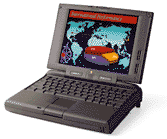- 2001.11.23
While I do have high-end equipment at home, I decided to take my
aging PowerBook 5300cs with me on
vacation to California. The 5300 is the slowest PowerPC-based
PowerBook, and at only 100 MHz is considered quite slow by today's
standards. I hadn't used my 5300 in a while, probably because of a
problem I'd been having with the screen. However, I decided to try
it again - and after running it for many hours, it seemed like the
problem had sorted itself out. I reformatted the hard drive and
reinstalled Mac OS 8.5 (I didn't have time to update to 8.6).
I installed some of the applications that I often use, such as
Microsoft Office. I also installed an MP3 player, GreyAmp, and
iTunes (yes, on 8.5) for Internet radio. I installed the software
for my PCMCIA ethernet card and hooked it up to my cable modem to
make sure the software was all working properly. I was amazed that
Internet performance was actually acceptable. Internet radio worked
fine. I then connected my 28.8 PCMCIA modem and was able to get on
the Internet without much trouble. I tried out the Internet radio
feature in iTunes, but the connection kept dropping, and it had to
reconnect to the server, so I didn't play with it much.
Right now I am on a plane heading toward San Francisco, and
unfortunately it looks like the screen problem has started
appearing again. The upper half of the screen gets taken over by
these red, green, and yellow vertical lines. When you press on
areas of the back, they lessen or go away (if you're really lucky).
Other than that, the 5300's screen is decent. It is passive matrix,
which means that it is of not as high quality as the active matrix
version, and using a computer with this type of screen tends to
make the computer feel "slow," as things (menus, dialogue boxes)
appear on the screen more  slowly than they would on an
active matrix screen and leave slight shadows after they go away.
An advantage to passive matrix is that anyone sitting next to you
cannot see what is happening on the screen, so your laptop is more
personal.
slowly than they would on an
active matrix screen and leave slight shadows after they go away.
An advantage to passive matrix is that anyone sitting next to you
cannot see what is happening on the screen, so your laptop is more
personal.
The other thing I like about the 5300 is its small size. It fits
easily under my arm and in my backpack. Some of today's laptops are
so large that they have trouble fitting in small spaces, which is
important to me when it comes to portability. This is why the "ice" iBook is almost the perfect
laptop (add a couple PCMCIA card slots and it would be perfect).
Sure, a large screen is really nice, but when the screen makes the
computer so large that it won't fit anywhere? I'd rather take a
smaller screen so I can have a smaller laptop. This is why I like
the 5300. The "ce" model would be just about the perfect low-end
laptop, as the screen is a decent 800 x 600, instead of 640 x 480 like
all of the other 5300 models.
Unfortunately there aren't any processor upgrade options for the
5300 series. I can't tell you why, but it is unfortunate because
the 5300 was popular, and I am sure that many owners would have
been interested in upgrading theirs - although it is a bit late
now, since many owners replaced theirs with a G3 or G4 PowerBooks.
A processor upgrade would not really be economical anymore because
the RAM in a 5300 can only be upgraded to 64 MB (mine has 48 MB),
and there would be no OS X support.
Even though a G3 upgrade isn't available, the 5300 is still a
useable machine. I will see how it gets me through the next few
days. If you get to read this, I have been successful in getting it
set up for email and the Internet in California.

 slowly than they would on an
active matrix screen and leave slight shadows after they go away.
An advantage to passive matrix is that anyone sitting next to you
cannot see what is happening on the screen, so your laptop is more
personal.
slowly than they would on an
active matrix screen and leave slight shadows after they go away.
An advantage to passive matrix is that anyone sitting next to you
cannot see what is happening on the screen, so your laptop is more
personal.
